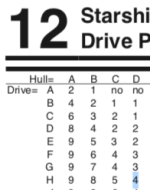AnotherDilbert
SOC-14 5K
OK, thanks. That undermines my position...First -- Marc did the designs himself. I saw the deckplan in 2017, and saw the design draft in 2019. Naturally I didn't see the overtonnage issue.
No? Overtonnage leads to increased hull size. I don't think added subhulls do.And the rules specifically deals with that, where added subhull stuff can cause an increase in the ship's base hull (regardless of detachability).
We just agreed that overtonnage is the difference between design tonnage and resulting tonnage?A "random" ship uses a main hull of 400 Dt + 20 Dt pod = 420 Dt (design tonnage). Drive performance is calculated for 420 Dt.
Hypothetically it stuffs enough components (422 Dt) into the main hull to get an overtonnage of 22 Dt. Resulting tonnage is 442 Dt (with the pod), overtonnage is 22 Dt, regardless of the pod is carried or not.
LOL! I see overtonnage as 42 tons, because the drives are pushing 42 tons over their rating. That seems to be what Overtonnage is for: performance calculations.
The drives are explicitly dimensioned for the design tonnage = 420 Dt, and might even be large enough for 500 Dt (without stage effects). Does not affect overtonnage?
Overtonnage is a penalty for an underdimensioned hull, not drives.
Hence overtonnage can be fixed by adding a subhull or pod, to increase the design tonnage?





